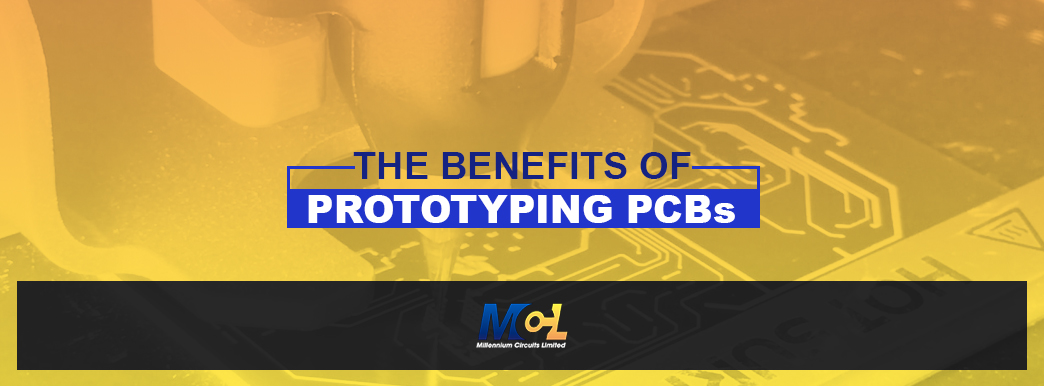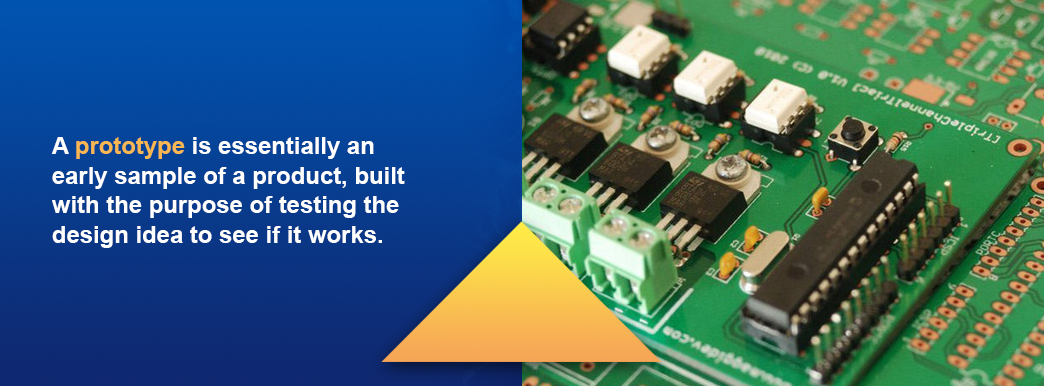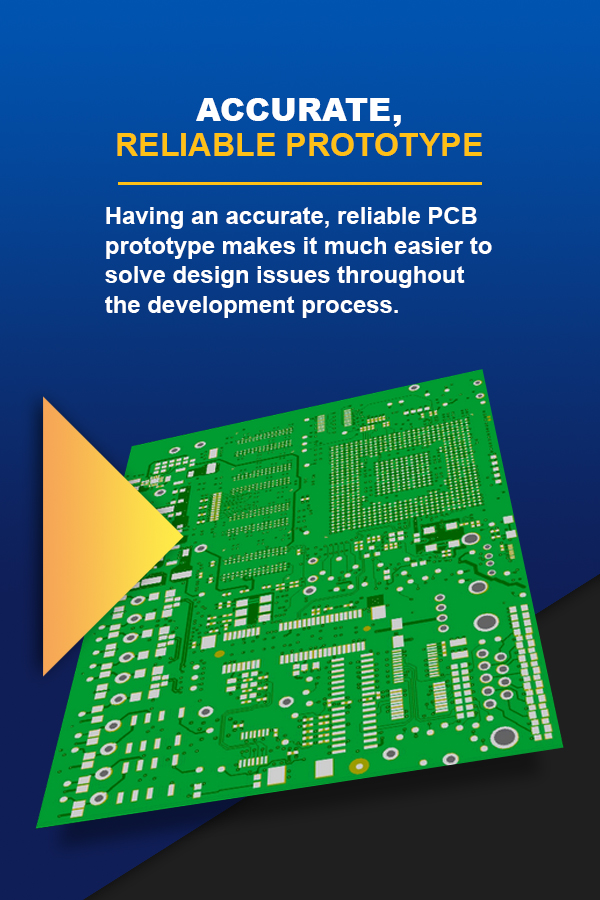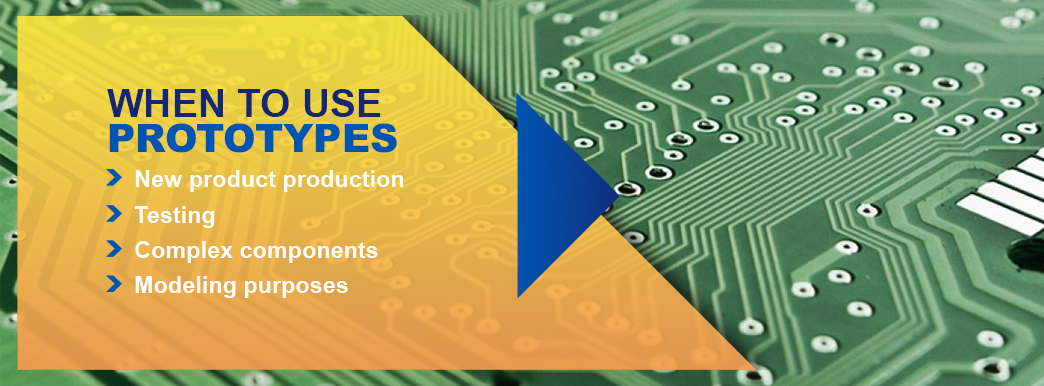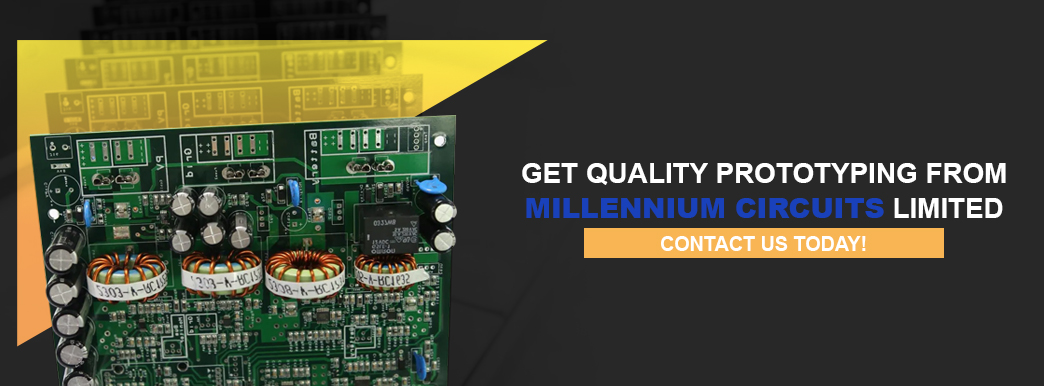Jump To:
The Benefits of Prototyping PCBs | What Is a PCB Prototype? | Benefits of Prototyping | 1. Reduced Timeline | 2. Manufacturing Review and Assistance | 3. Accurate, Reliable Prototype | 4. Test Components Individually | 5. Reduced Costs | When to Use Prototypes | Get Quality Prototyping From Millennium Circuits Limited
Benefits of Prototyping PCBs
Before beginning a full production run, it’s essential to ensure that a printed circuit board (PCB) is functioning properly. Regardless of how carefully designers work on the project, small mistakes and invisible problems always pose a threat to the functionality of the final product. If these problems aren’t caught before full production, it can be extremely costly for the project as a whole. As a result, many engineers regularly order prototype boards before full-scale manufacturing.
Prototyping is one of the essential services we offer at Millennium Circuits Limited, but not everyone is familiar with prototype services and their benefits to product quality. That’s what we’re here to explain.
What Is a PCB Prototype?
A PCB prototype is essentially an early sample of a product, built with the purpose of testing the design idea to see if it works. While most prototypes are made simply to test basic user functionality, PCB prototypes have the added need to be somewhat, if not entirely, functional. This is because PCB prototypes are made to test the total functionality of the design.
Different types of PCB prototypes are used to test different aspects of the design. Over the course of a project, a design team may use multiple PCBs at various stages of the design process. Some of these prototype types include:
- Visual models: Visual models are used to illustrate the physical aspects of the PCB design and show the overall shape and component structure. These are usually the first prototypes in the design process, and they are used to communicate and review the design in a way that is easy and affordable.
- Proof-of-concept prototype: Proof-of-concept prototypes are simple prototypes that focus on replicating the primary function of the board without carrying all of the capabilities of the final product. This kind of prototype is primarily meant to show that the design concept is viable.
- Working prototype: Working prototypes are functioning boards that contain all of the planned features and functions of the final product. These are usually tested to identify weaknesses or problems in the design and rarely represent what the finished product is going to look like.
- Functional prototype: Functional prototypes are meant to be as close to the final product as possible, providing the most accurate idea of what the design will look like and how it will work, with some basic material differences to keep prototyping costs low.
Engineers will usually work through this list from top to bottom throughout the design and testing process, starting with a visual model and ending with a functional prototype.
Benefits of Prototyping
PCB designers use prototype PCBs throughout the design process, repeatedly testing the functionality of their solution with every new addition or change. But, why do designers choose to use PCB prototypes instead of going straight into standard production runs?
While it may seem like prototypes add several steps and costs to the process, prototypes serve important functions in the design process. Prototyping allows designers, their teams and clients to test at multiple stages of design and make adjustments as needed to tailor the solution before the full production run. This creates several advantages for the client and designers, which are detailed below.
1. Reduced Timeline
When developing a PCB design, engineers will go through several iterations before creating the final product. While this can create lengthy timelines, PCB prototypes can help speed up the design and manufacturing process as a whole through the following means:
- Complete testing: PCB prototypes enable design teams to test designs and spot problems quickly and accurately, taking the guesswork out of the equation. Without this, spotting flaws would take significantly more time, potentially resulting in a longer time frame, lost revenue and unhappy customers.
- Visual assistance: Clients often want to see the product at several points in the production process, and providing prototypes as visual aids can help communicate the design more easily. This helps minimize time spent on explanations and client-requested redesigns.
- Minimized rework: Prototype testing allows you to see and test the board before a full production run. If a faulty product goes all the way to production, the required rework to fix the problem will take significantly longer and cost much more money.
These benefits are maximized when you work with a PCB supplier that specializes in quick PCB prototype turnaround. MCL’s in-house service creates high-quality prototypes, reducing the time frame for fabricating prototypes from weeks to minutes while also making sure you are independent of service suppliers.
2. Manufacturing Review and Assistance
When using a third party PCB prototyping service, companies can benefit from the assistance of a new set of eyes. Several things can go wrong in the design process that result in mistakes, including:
- Excessive input: In the design process, customer and team changes can build up and overlap to the point where the design is unrecognizable compared to its first iteration. Eventually, the designers may simply lose track of design best practices in the rush to meet client demands.
- Design blindspots: Designers are human, and humans have blind spots. While a designer may create fantastic PCBs of one specific type, they may have less experience in another area and subsequently create a small problem in the design.
- Design-rule-check (DRC): While DRC tools are extremely helpful to catch glaring problems in a design, they have limitations. As an example, DRCs can verify that a return path to ground exists, but may not determine the best trace geometry, size and length to get the best results from that path.
These problems can result in inefficiencies, design flaws and other issues that designers miss in the review process. Third-party prototyping services are primed to catch these small problems. As a result, they can make design improvement suggestions before prototyping, making the prototype even more ready for the testing process.
This doesn’t mean that companies should work independently from their prototyping company — in fact, the opposite is true. Industry professionals recommend working closely with your prototype supplier to make the most of their expertise, adjust designs to their strengths and avoid technical issues like tool incompatibility.
3. Accurate, Reliable Prototype
Having an accurate, reliable PCB prototype makes it much easier to solve design issues throughout the development process. Quality PCB prototypes accurately represent the functionality of your final product, allowing designers to see and test the following aspects:
- PCB design: Prototyping enables designers to catch flaws early in the development process, and the more accurate the design, the more accurate the identification of the flaw. This helps minimize design costs down the line, while also reducing the project timeline.
- Functional testing: What works in theory doesn’t always work in practice. Accurate PCB boards will help assess the theoretical values of the board to see if they show up in the practical values. This allows any differences in value to be checked, updated and potentially reevaluated.
- Conditional testing: The real world is a brutal environment for products, so it is essential that PCB products go through appropriate testing to ensure that they will survive environmental conditions. For example, prototypes typically undergo temperature variation testing, power variation testing, shock resistance testing and more.
- Final product design: PCBs are usually incorporated into a final product, and prototypes help determine if the planned product or packaging need to be adjusted for the final PCB design.
For these purposes, having an accurate PCB prototype will help make other processes significantly easier, and will better prepare design teams for what to expect when they begin production runs.
4. Test Components Individually
Engineers frequently use prototype PCBs for testing, but the most beneficial testing occurs with simple PCBs that test singular components and functions. These prototype PCBs test single functions that are meant to be incorporated into a larger PCB, ensuring that they work as expected. This type of testing can be used for many purposes, including:
- Testing design theories: Simple PCB prototypes are used in proof-of-concept runs, allowing engineers to see and test a design idea before it goes further into the design process. This allows engineers to see whether the design works and, if it doesn’t, figure out what went wrong.
- Breaking down complex designs: Often, simple PCB prototypes break down the basic parts of a final PCB, ensuring that the design performs one basic function before moving on to the next. This piece-by-piece testing helps identify design issues in a compartmentalized manner, allowing for quicker, more accurate adjustments.
This individual testing method allows designers to test singular functions effectively and efficiently without ordering an entire PCB and breaking it down to figure out the problem when it doesn’t work.
5. Reduced Costs
Standard PCB production runs can get costly, and leaving things to chance can increase the bill. Prototypes are essential for reducing production costs because they help designers address and avoid the following issues:
- Catching design flaws: The sooner the development team catches a design flaw, the sooner it can be fixed and the less costly the fix is. The later on in the process the problem is caught, the more expensive the fix. If a problem persists all the way to full-scale production, it’ll likely destroy the budget completely. With a high-quality PCB prototyping service, design teams can catch and fix problems quickly and accurately, reducing costs in the long run.
- Pinpointing cost-saving adjustments: Depending on the specific design of a PCB, there may be several options available for materials and components. Prototyping allows design teams to test out different permutations of components, materials and assembly methods to find the one that best balances cost and functionality.
- Determining product adjustments: In some cases, adjustments to the PCB will result in the PCB taking on a slightly different shape or material than originally planned, which may affect the specifications and manufacturing needs of the product as a whole. Prototyping can help determine whether product adjustments are needed early on, allowing for improved planning and reduced redesign costs for the product and any associated packaging.
In short, prototyping services can help improve your product quality while reducing the cost of your manufacturing process as a whole.
When to Use Prototypes
Prototypes are essential to the testing and design process as a whole, but if you’re looking to keep prototyping costs to a minimum, here are the most essential conditions in which to use prototypes:
- New product production: If a project involves a novel design or function, prototyping is going to be critical. Prototyping allows the design team to test the desired function and the design as a whole, which enables them to detect issues early on in the design process. Even in cases where the project is similar to one your team has done before, prototyping is essential to ensure the overall functionality of your product before you continue with the design process.
- Testing: For any type of testing, from quality assurance tests to environmental tests, prototypes are a necessity. Rapid prototype PCB production allows your team to begin conducting tests quickly to prepare for official third-party testing, and the more accurate the PCB, the more accurate the tests.
- Complex components: If a project is particularly complex, containing multiple components and structures, prototyping is going to be the best option. Complex structures are notoriously difficult to fix when problems occur, and breaking each function down with simple PCB prototyping can help pinpoint problems early on in the design process. This way, your team will spend less time figuring out the source of the issue and more time improving the overall product quality of your circuit boards.
- Modeling purposes: Sometimes you need a visual representation of the physical design, but don’t need a functioning PCB. In this case, a prototype made with basic materials can be an excellent solution. This way, you can have the visual aid without spending money on a standard production board.
Because of the benefits of PCB prototyping, industry professionals generally recommend that prototyping be used to test any design revisions. Though these rapid prototype PCB productions do present upfront costs, they’re a cost-effective way to improve product quality every time.
Get Quality Prototyping From Millennium Circuits Limited
PCB prototyping is a powerful tool for designers, offering time and cost-saving benefits while also ensuring that your final product is top-quality. If you are interested in using PCB prototype services for your next project, contact Millennium Circuits Limited today.
MCL is a leader in PCB prototype services, serving over 400 clients across the United States. Our attention to detail and commitment to quality is what makes us stand out from the crowd, fabricating complete, accurate prototypes to your specifications every time. Our PCB design experts can deliver virtually any type of PCB prototype, from single and double-sided FR4 boards to complex multi-layered prototypes. MCL can provide your prototype quickly, efficiently and cost-effectively, with no hidden fees.
Our process is simple — we use CAD software to prepare the prototype layout, choose the material for fabrication then cut and assemble the board. From there, you’ve got a circuit board that’s ready to test. Once you’re ready, we’ll also help you transition from prototyping to the manufacturing process.
If you’re ready to work with a company that can help you benefit from high-quality PCB prototype services, MCL is ready to help. Contact us today to speak with one of our service team members about how MCL can meet all of your PCB prototyping needs.


